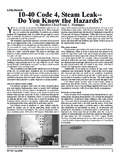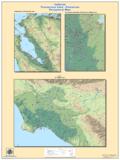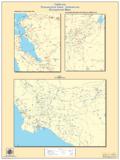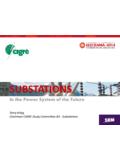Transcription of Utility Hazards Electric Substations Overview, …
1 Utility Hazards Electric Substations overview , Hazards and Response Tactics by Battalion Chief Frank C. Montagna and Anthony J. Natale, Emergency Response Group, Con Edison Y. ou are a covering Captain working in a ladder company. At Transmission 0340 hours, you find yourself responding to a report of an Substations typical- explosion near the South Street Seaport. The dispatcher ly receive a states that there were numerous calls. As you arrive, you see heavy 345,000-volt feed, smoke rising over the roof of what appears to be a garden-variety, which is stepped five-story, brick commercial building. (See Photo #1.) You trans- down or reduced mit the 10-75 and provide the address of the fire to the dispatcher. through a trans- The dispatcher informs you that there is CIDS information avail- former to 138,000. able and it turns out that this two-story commercial building is volts. Following actually a Con Edison Electric substation. this voltage reduc- Currently, your forcible entry team is sizing up the front door tion, power then is for entry.
2 Do you let them force the door? What Hazards are wait- routed to a distribu- ing for you inside the building? Will you encounter PCBs? What tion substation. actions do you take to protect yourself and the Firefighters? Is Distribution substa- Photo #1--From the exterior, the Con Edison substa- there a life hazard inside? Since you've arrived, conditions have tions receive the tion appears to be a five-story building. deteriorated and the smoke is heavier. The engine is stretching a 138,000-volt feed Bus 21/2-inch line to the front door. Do you want them to put water on and continue to step the fire? Can you confidently answer the above questions? it down further to This article will provide vital information to help keep you supply the various safe when responding to fires and emergencies at electrical substa- distribution net- tions. It includes a substation overview , points out the Hazards you works. When may encounter and offers the recommended tactics for incidents at power leaves a dis- these facilities.
3 Tribution substation, voltage is propor- Substation overview tionate to the Electricity is produced at steam- or gas-fueled generating stations requirements of the and is routed to Electric Substations for distribution to the areas they network it supports. support. (See Diagram #1.) There are two types of Substations --trans- Brooklyn and Photo #2--Exposed electrical conductors. mission and distribution--and both act as a transportation hub for Queens are sup- power. The difference between a transmission and distribution substa- plied with 27,000 volts. Manhattan and the Bronx receive 13,000. tion is the voltage present and to whom the Electric supplies go. volts. Staten Island is supplied with both 13,000 and 33,000 volts. To accommodate the end user, further voltage reduc- Diagram #1--Electrical path from generation tion occurs on the pole and/or underground trans- station and transmission feeders to customers formers in the field.
4 Commercial voltages range from 277/460 volts, while standard residential volt- age is 120/208 volts. Overhead clearance and exposed conductors What most of us know about electrical safety is Distribution Substation related to what we've learned in our homes. As a result, many of us think we have to touch a con- ductor to get hurt. In the home, electrical conduc- artwork courtesy of Con Edison tors are insulated in a plastic coating and run in a plastic jacket--Romex--or in a metal jacket--BX. In some applications, these plastic-coated wires are run in conduit. If you were to come in contact with these wires or the conduit, the insulation would protect you from the electrically charged wire. This is not true in a substation, however. Substations use open-air conductors--called bus-- which resemble three-inch conduit pipe. (See Photo #2.) This is not conduit. These metal pipes running through the overhead areas of a substation are the conductors.
5 Electricity carries on the skin 14 WNYF 1st/2007. Voltage Clearance chemicals, which can 15 kV 10 feet be found in substa- 27 kV 10 feet tions, include dielectric 33 kV 10 feet fluid, transformer oil, 69 kV 10 feet Edisol XT, sulfuric 138 kV 10 feet acid and sulfur hexa- 345 kV 18 feet fluoride. Excluding sulfuric acid, these of the pipe. There are no products serve to insu- internal wires. late and cool the elec- Just knowing what the con- trical conductors. Photo #3--Capacitor banks reside in cages ductor looks like is not Dielectric fluid is that provide a buffer zone between you enough to keep you safe. an insulating oil and the exposed electrical conductors. Many believe that they are used in under- Photo #7--Exposed underground feeder lines. safe from electricity as ground transmis- long as they do not come in sion feeders. contact with the bus. This (Photos #7 and #8. is not true. Due to the show underground extremely high voltage 345kV feeders.)
6 Carried on bus, clearance This non-PCB oil of up to 18 feet may be resembles cooking required between you and oil, has a flash point the conductor to ensure of 350 degrees safety. Fahrenheit and an The proper clearance from auto-ignition tem- overhead bus has been cal- perature of 795 Photo #8--Cutaway of underground feeder line. culated for each station. degrees Fahrenheit. Photo #4--Circuit breakers are housed in Conductors have been posi- Note that electrical locked cubicles to eliminate the chance of tioned accordingly, using a arcs can produce anyone casually entering these areas. conservative distance to temperatures up to ensure the safety of anyone 7000 degrees walking through a station. Fahrenheit. To stay safe inside a substa- Transformers also tion, do not climb and do use insulating oil, not carry tools above your which is simply shoulder. classified as trans- former oil. The Ground level clearance flash point is and exposed conductors approximately 300.
7 Overhead bus is not the degrees Fahrenheit. Photo #9--Oil-filled bushing. only electrical hazard pres- Historically, this is ent. Many electrical haz- where PCBs have been found. Over the years, Con Edison has ards can be found at ground successfully worked to remove PCBs from its system through a Photo #5--Lightning arrestors are found level. However, access to process called retro-filling. This is somewhat similar to changing behind fences. Remaining outside of these these Hazards is restricted fenced areas ensures your safety. the antifreeze in a car; the old product is drained and the new through locks, cages and product is put in. Unfortunately, there are certain oil-filled com- fenced-in areas. ponents that cannot be retro-filled and have no sampling ports. Capacitor banks reside in cages, providing a buffer zone between (See Photo #9.) Their PCB content is unknown. As a result, you and the exposed electrical conductors. (See Photo #3.)
8 When we respond to fires or other emergency conditions, we Circuit breakers are housed in locked cubicles to eliminate the chance assume the oil contains more than 50 ppm/PCB until sampling of anyone casually entering into these areas. (See Photo #4.) proves otherwise. Lightning arrestors and various other electrical components may Oil involved in fire will be sampled to identify the existence and be found behind fences. Remaining on the outside of these quantity of PCBs. Representative samples are obtained once the fenced areas ensures your safety. (See Photo #5.) area is made safe. Results usually are available in six to eight Please note that hours. (See AUC 266, PCB Incidents.). signs indicating PPE should be worn to protect members from potential dermal the Hazards are and respiratory exposure to PCBs. posted and they Edisol XT is a viscous-type of insulating oil used in capacitor should not be banks. (See Photos #3 and #10.)
9 It is non-PCB oil and has a flash ignored. (See point of 284 degrees Fahrenheit. MSDS information indicates Photo #6.) that dermal exposure results in skin irritation, consistent with most petroleum exposures. Chemical Hazards Sulfuric acid is contained in the lead/acid batteries used in the Photo #6--Signs indicating the Hazards are posted The five basic back-up power source for the facility. Each substation has two and they should be followed. WNYF 1st/2007 15. b a t t e r y scavenger and will eat through rooms, each the skin and aggressively attack of which the bones. The key to successful contains 30 treatment is early recognition of to 40 car- the symptoms of exposure and type batter- obtaining medical attention in a ies. (See timely manner. MSDS informa- Photo #11.) tion recommends the use of cal- Each battery cium gluconate, a gel that contains five impedes the effects of the to 10 gallons Photo #10--Edisol XT is a viscous-type of insulating oil process.
10 Of acid with used in capacitor banks. Photo #13--Identifying logos are a 30 to 40 Response tactics placed at the main entrance for each site and have been entered percent con- Because of the hazardous into the CIDS program. centration. environment found in Substations , Exposure to Firefighters must resist their natural tendency toward aggressive sulfuric acid tactics. These incidents require specialized knowledge, close control under nor- of operating personnel and a heightened sense of caution. The first- mal condi- responding Officers must closely supervise their Firefighters to tions pres- ensure their safety. All members operating at the scene must be ents a dermal aware of the potential dangers and act to safeguard themselves from hazard, but such dangers. The Con Edison white hat will provide the special- more signifi- ized knowledge required to safely operate at a substation incident. cant issues Photo #11--Each substation has two battery rooms, with The FDNY and Con Edison have worked together to develop arise when each room holding 30 to 40 car-type batteries.






